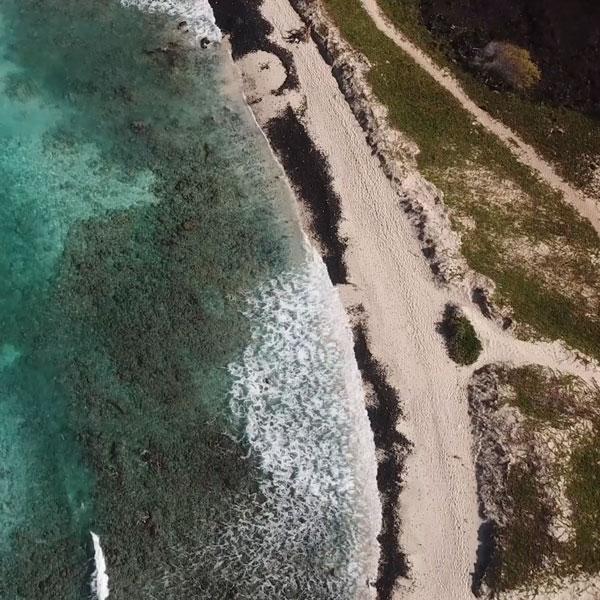Now that you have a drone, you’re probably antsy to fly. But where to go? While it might seem like you can launch your drone just about anywhere with a clear sky, UAV flight is becoming more restricted in many counties across the globe as drones becomes more popular each year.
Some countries like Egypt, for example, have really cracked down on UAV’s, for both commercial and recreational use, nearly banning them outright. Other countries have realized that drones can help bring tourism, and have made it a little easier to legally fly while on vacation, provided the content isn’t for commercial use, and that you adhere to both local and federal law. To be safe, you’ll want to research beforehand the local laws regarding drones in the country you’d like to visit.
While there’s increasing more red tape regarding the use of drones everywhere, the good news is the world is large, and still full of wonder. There are still plenty of awe inspiring paces that are relatively easy to fly in, and are simply breathtaking from an aerial perspective. Here are some great drone destinations to fuel your wanderlust this summer.
The Lost California Coast (Big Sur)
The Sunshine State has it all, from snowcapped mountains to pristine beaches that stretch along 840 plus miles of coastline. Big Sur, on the central coast between San Francisco and LA, is worth checking out anytime of the year. It’s rather foggy during the summer months on this rugged undeveloped coastline, so you’ll need to be patient to wait for clear skies. When the sun does finally burn off some of the marine layer, don’t miss opportunity to get some stellar footage of this stretch of land lost to time. Make sure to check for any postings at the specific location that you want to fly in Big Sur, as restrictions do apply. Parts of Big Sur closet to LA are in the Los Padres National Forest, which is federal land, meaning you can’t fly there without permission (good luck with that). If you have any doubts about taking flight, ask a California State Park representative. Another great way to see the coast is on the Nacimiento - Fergusson Rd. This winding road connects Highway 101 east of the San Lucians to Monterey County’s Cabrillo Highway (Highway 1) on the coast of Big Sur. Be sure to make the sea-to-sky day hike to Cone Peak, which has the steepest coastal elevation in the lower 48 states. As you head south into San Luis Obispo, be sure to stop in Morro Bay for a shot of Morro Rock, a massive geological landmark seemingly plopped into the bay.
Hawaii
If California has you jaded, or there’s simply not enough coast to capture, jet on over to Hawaii. It’s an island after all, and a tropical paradise at that. Shoot as many popular locations as you can, as they are easily accessible. There really isn’t anywhere on this lush island chain that is not interesting to shoot from up high. That said, there are restrictions. Since many locations on any of the islands are within 5 miles of an airport, you’ll need to call the FAA for permission to fly. It should be fairly easy to get permission for non-commercial use. On federal land like Volcanoes National Park on the Big Island, you probably won’t have luck asking the FAA to fly (but the various hot lava flows are still worth checking out).

Alaska
If you want to get a little further from the tropics, the cold isolation of Alaska calls. From Anchorage, you can take a ferry to the Aleutian Islands, the island chain archipelago that spans toward Russia. Be sure to capture at least one of the many glaciers making up Alaska’s massive glacier fields. An aerial view of these blue floating giants is both breathtaking and humbling. While we didn’t get out to the Aleutians on our recent trip to Alaska, we had a blast shooting the Portage Glacier on the Kenai Peninsula. Take Highway 1 for 60 miles southwest from Anchorage.
From mid September through April is your best chance of catching the Northern Lights. Head up to Fairbanks, which is just 140 nautical miles from the Arctic Circle. Taking Highway 3 from Anchorage to Fairbanks, you’ll pass though Denali National Park. You’ll be fined heavily if you fly inside the park, but there’s plenty of open range on the way to Fairbanks to launch your drone.
If you really want to see the Northern Lights, there’s Barrow, 320 miles above of the Arctic Circle, and the northernmost “city” in the United States. Keep in mind, Barrow is only accessible by air during the winter and by boat or plane in the summer. As with anywhere in the US, be sure to register your drone with the FAA, even if for recreational use only. For commercial use, contact local government.
Iceland
Iceland is dark most of the winter, but in the summer you’ll have all the time in the day to roam this green land. A quiet Nordic island in the North Atlantic, Iceland is only a short flight from North America and Europe. The island’s mystic allure is in no small part due to lush green hills that roll as far as the eye can see, ending abruptly at staggering cliff faces that fall into the ocean. Iceland also has its fair share of fjords shaped by glaciated valleys. With the majority of its population living in the costal capital, Reykjavík, most of Greenland is unpopulated, leaving you with open country to roam. In fact, it’s the least populated country in Europe, and there’s just one highway connecting Reykjavík to the rest of the island, aptly named Route 1. Along Route 1, you’ll have more than enough room to let your drone roam. Drone laws are relatively loose, but be sure to do your research. In most areas you can do as you please, since no one is usually around to watch. That said, don’t abuse your power. At tourist hotspots like the Bruarfoss Waterfall be sure to ask permission of those around you, and be respectful when someone asks you not to fly around them. Here, you’ll have plenty more opportunities away from the crowds to do your thing. You may even get lucky and catch some of Iceland’s majestic horses roaming wild. Also be sure to check out the geothermal springs and geysers that dot the island.

Scotland (Highlands)
Another country known for pristine green scapes juxtaposed against craggy seaside cliffs, Scotland is another interesting place to vacation with a drone. The northernmost country in Great Britain, and recently voted 2017 Most Beautiful Country by Rough Guides, Scotland has breathtaking mountains, rolling hills, and is dotted by pristine freshwater lochs and fjords cutting in from the sea. Head north to the Highlands, where you won’t have to worry much about running into crowds.
The non-commercial use of drones is permitted in all of the UK under the rules laid out in the 2016 Air Navigation Order. For more details on drone law in the UK, visit caa.co.uk
Hong Kong, China
Hong Kong is less restricted concerning UAV’s than the rest of China. This bustling city’s location at the mouth of the Pearl River Delta on the South China Sea makes it a dynamic melting pot of traditional Chinese culture and international trade. Nearly 3/4 of the city is covered in green space, and aside from the main centers many of its neighborhoods are situated in the mountains.
You will have to register your drone with the CAAC before you fly in Hong Kong, but you won’t need an actual drone license unless your drone is over 15 lbs. If using a DJI drone, Hong Kong’s No Fly Zones are all mapped out for you in the DJI Go 4 app. In a nutshell, you can’t fly higher than 400 feet or over crowds and urban centers or outside your VLOS (visual line of sight). While that makes most of Hong Kong sound off limits, you’ll actually be able to get some killer shots from the numerous green spaces throughout and surrounding the city. Take a day hike on the High Junk Peak Country Trail in Clearwater Bay Park to catch a spectacular view of the city line. From nearby Miu Tsai Tun, you’ll be able to see High Junk Peak and capture both the city below and Clearwater Bay in the background with just a quick flight. For a full list of UAV regulations, see the CAAC’s website: https://uas.caac.gov.cn/login
New Zealand
Weather you head to the North Island, South Island, or both, you can’t go wrong in Aotearoa, “the land of the long white cloud.” What’s great about flying drones in New Zealand is that the laws surrounding both their private and commercial use are relatively lax. Similar to the US and many other western countries, you won’t be able to fly a drone near airports, in National Parks or UNESCO historical sites, over large crowds or buildings, and you’ll need to keep your drone in your line of sight. But unlike the US in particular, you won’t have to register your drone with any government agency. However, you’ll need permission for certain maneuvers, like flying FPV outside your line of sight, or in restricted airspaces, such as near an airport or military operation.
One National Park designation worth checking out on the South Island is Tasman Glacier, New Zealand’s largest glacier that flows to the Mackenzie Basin in the Southern Alps. While you technically can’t fly there, it’s worth seeking special permission beforehand, and even if you’re denied, if you have a small drone like DJI’s Mavic Air, you can mount it to a camera tray and use your drone as a handheld camera.
On the North Island’s east coast, hit Cathedral Cove for some great photo ops, nestled in the Te Whanganui-A-Hei Marine Preserve, and not unlike California’s Big Sur.
Resources for flying in NZ can be found at the Department of Conservation’s website: http://www.doc.govt.nz/get-involved/apply-for-permits/business-or-activity/aircraft-activities/ and also AirShare, which provides detailed flight maps of the North Island and South Island: https://www.airshare.co.nz/maps.
Valletta, Malta
Along with Leeuwarden in the Netherlands, Valletta, Malta has been named 2018’s European Capital of Culture. The smallest capital city in the European Union, and the first European city to be holistically designed, the entire town of Malta has been established as a UNESCO World Heritage Site. Malta is said to have 365 cathedrals, one for each day, and Valletta boasts a fair share, as well as Baroque government buildings and fortified walls. Climb atop one of the walls in the evening for a romantic view of the city. Because Valletta itself is a landmark, you can’t fly over any of the buildings, but you can get some spectacular shots from the sea. Be sure to register your drone with the Maltese government before you go, and always fly within your line of sight. You can view full details of Maltese drone law and fill out the Airworthiness applications here: http://www.transport.gov.mt/aviation/aircraft-flight-standards/airworthiness/airworthiness-forms
Know Before You Go
Before taking off on your own drone-cation, be sure to check the rules and regulations surrounding the use of UAV’s in country you want to fly in, and be sure to pack up your drone according to your airline’s travel guidelines.
Many countries have federal laws as well as state, city or region specific laws regarding drones, so be informed. Federal regulations usually have to do with restrictions around National Parks, airports, military operations or government buildings, while local law regulates airspace in crowded areas of cities like tourist hotspots. Also keep in mind that any UNESCO world heritage sites require special permission.
If you want to fly somewhere you are unsure that you legally can, it never hurts to ask an authority, or the landowner if on private property. Drones are still gaining acceptance in many parts of the world, so it’s important to be a positive representative for the drone community. Wherever you end up, remember to fly responsibly.



Share:
5 of the Best "Royalty-Free" Music Sources
Choosing a Drone; Consumer Edition: DJI’s Spark vs Mavic vs Phantom 4 Pro